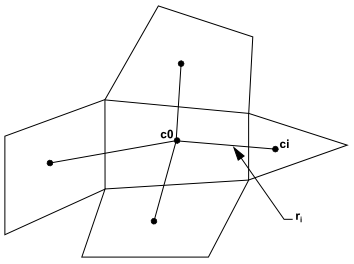Gradients are needed not only for constructing values of a scalar
at the cell faces, but also for computing secondary diffusion terms
and velocity derivatives. The gradient of a given variable
is used to discretize the
convection and diffusion terms in the flow conservation equations.
The gradients are computed in Ansys Fluent according to the following
methods:
Green-Gauss Cell-Based
Green-Gauss Node-Based
Least Squares Cell-Based
To learn how to apply the various gradients, see Choosing the Spatial Discretization Scheme in the User's Guide.
When the Green-Gauss theorem is used to compute the gradient
of the scalar at the cell center
, the following
discrete form is written as
(23–30) |
where is the value of
at the cell face centroid,
computed as shown in the sections below. The summation is over all
the faces enclosing the cell.
By default, the face value, , in Equation 23–30 is taken from the arithmetic average
of the values at the neighboring cell centers, that is,
(23–31) |
Alternatively, can be computed by the arithmetic
average of the nodal values on the face.
(23–32) |
where is the number of nodes on the
face.
The nodal values, in Equation 23–32, are constructed from the weighted average
of the cell values surrounding the nodes, following the approach originally
proposed by Holmes and Connel [255] and
Rauch et al. [545]. This scheme reconstructs
exact values of a linear function at a node from surrounding cell-centered
values on arbitrary unstructured meshes by solving a constrained minimization
problem, preserving a second-order spatial accuracy.
The node-based gradient is known to be more accurate than the cell-based gradient particularly on irregular (skewed and distorted) unstructured meshes, however, it is relatively more expensive to compute than the cell-based gradient scheme.
In the density-based solver, the stability of the node-based gradient can be reduced by the presence of tetrahedral elements along domain boundaries. To regain robustness on tetrahedral and mixed meshes, it is recommended to select the extended node-based boundary option, available under the text command:
solve/set/nb-gradient-boundary-option? yes yes
By default, the density-based solver uses an improved treatment of symmetry and periodic boundaries in the node-based reconstruction gradient. This treatment ensures that the gradient respects symmetry and periodic constraints at the discrete level, thus better matching results obtained on an untruncated domain. This treatment can be controlled with the text command:
solve/set/nb-gradient-improved-symmetry-periodic? yes/no
In this method the solution is assumed to vary linearly. In
Figure 23.6: Cell Centroid Evaluation, the change in cell values
between cell and
along the vector
from the centroid of cell
to cell
, can be expressed
as
(23–33) |
If we write similar equations for each cell surrounding the cell c0, we obtain the following system written in compact form:
(23–34) |
Where [J] is the coefficient matrix that is purely a function of geometry.
The objective here is to determine the cell gradient () by solving the minimization problem for
the system of the non-square coefficient matrix in a least-squares
sense.
The above linear-system of equation is over-determined and can
be solved by decomposing the coefficient matrix using the Gram-Schmidt
process [19]. This decomposition
yields a matrix of weights for each cell. Thus for our cell-centered
scheme this means that the three components of the weights () are produced for each of the faces of cell c0.
Therefore, the gradient at the cell center can then be computed
by multiplying the weight factors by the difference vector ,
(23–35) |
(23–36) |
(23–37) |
On irregular (skewed and distorted) unstructured meshes, the accuracy of the least-squares gradient method is comparable to that of the node-based gradient (and both are much more superior compared to the cell-based gradient). However, it is less expensive to compute the least-squares gradient than the node-based gradient. Therefore, it has been selected as the default gradient method in the Ansys Fluent solver.



